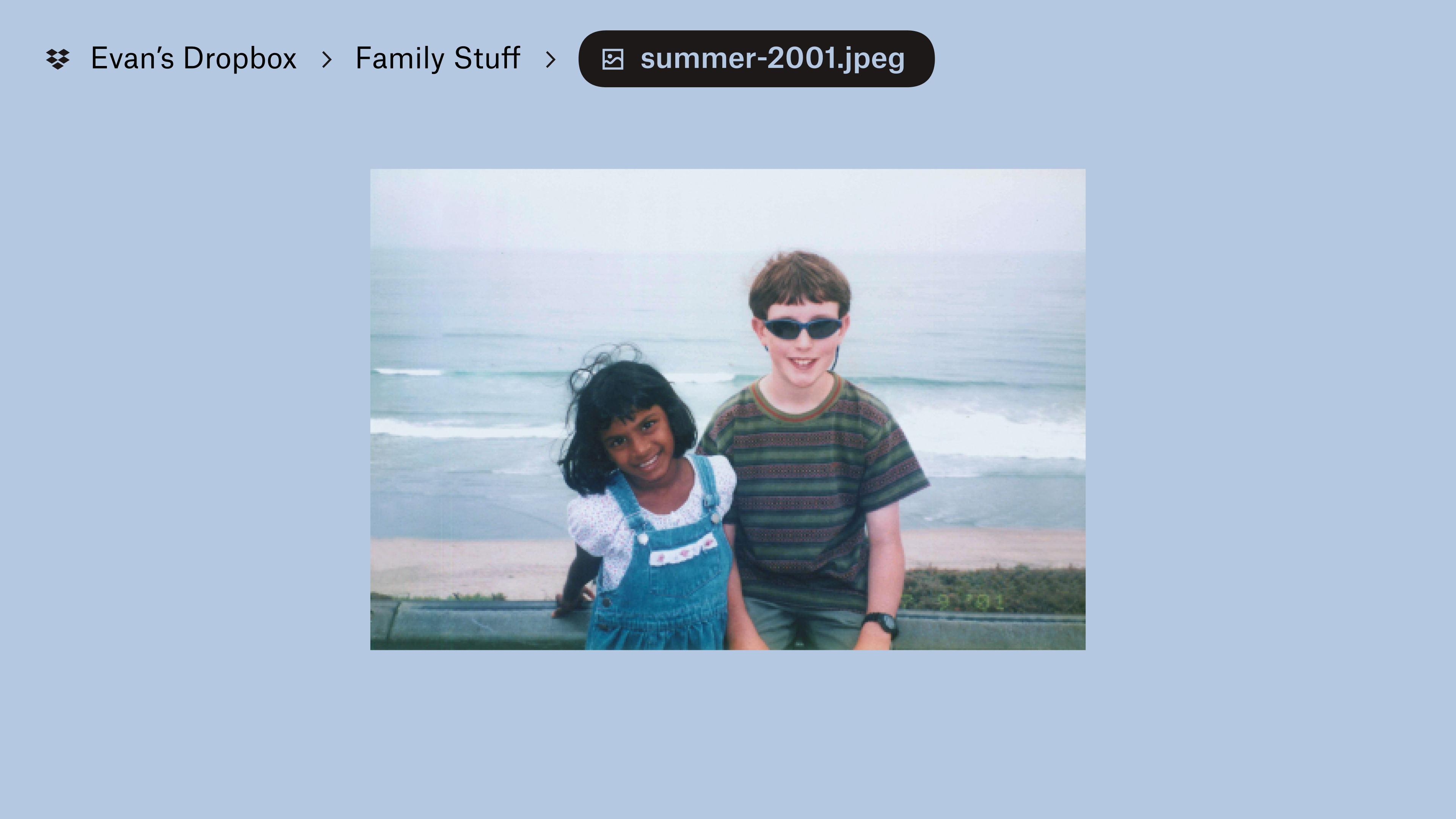Who hasn’t been on the receiving end of a huge email file transfer—or an endless group text thread—full of irreplaceable family photos? In the moment, it’s great to see them but can you find them in six months? Here are a few signs your current photo sharing setup has issues:
- Files get buried in email chains or lost when inboxes fill up
- Group chats move fast—photos disappear under a pile of new messages
- Large attachments clog up your storage or fail to download
- No tags, folders or search means you’re scrolling endlessly to find one photo
- When it’s time to print or relive a memory, those scattered photos are nowhere to be found
A shared cloud folder keeps everything organised, easy to access and right where you need it—even months (or years) later.
Dropbox to the rescue. We make it easy—with plans that start at 0 USD—to stay connected with your loved ones for years and years to come. Share folders, photos and videos of your nephew carving the Sunday roast, and do it all without breaking a sweat.
These days, it couldn’t be easier to keep a digital photo album, whether for your personal or professional needs. Here’s our introduction to the photo storage and sharing options on the market right now.
What’s the best way to share photos?

OK, yes, you got us: we’re partial to our own product! We’ve made it simple to upload, organise and share photos and files using cloud storage. Whether they’re holiday snaps or your retirement portfolio, we keep them safe and secure—the virtual version of a fireproof box.
It’s easy to upload photos straight from your phone using our app and just as simple to share a link with family members—without overwhelming their inboxes.
You can even share a Dropbox Family plan with up to six people. Everyone has their own space and a shared folder where all family members can store and access shared photos.

Upload & sync photos
Yes, you can do everything but make dinner using Dropbox and our app. Here are some examples:
- Camera uploads: upload photos automatically to Dropbox from your mobile device. Simply download the Dropbox mobile app to get started.
- Computer uploads: drag and drop from your computer desktop to your Dropbox.
- Scan old photos: use the Dropbox doc scanner feature to turn beloved physical photos into digital files using your phone.
Once your photos are uploaded, they stay in sync across all your devices—no matter where you are. That means your entire photo library is always up to date, organised and just a few clicks or taps away when you need it most.
Organise & Store Photos
We also make it easy to stay organised despite even the most cluttered computer. Here’s how:
- Thumbnail previews allow you to scan for the faces you want to see.
- Dropbox Professional users can search images based on their content. (For example, search images of "mountains", even if it isn't in the file name.)
- Keep photos and folders secure with a personalised password.
- Searchable hashtags help keep photos organised.
Instead of digging through random folders or scrolling endlessly, you can find the exact photo you need in seconds. It’s like turning your photo chaos into a calm, beautifully labelled archive—without the hassle.
How much space do I get?
Dropbox users get 2 GB of storage space in a free account, with paid plans such as Dropbox Family offering even more space and sharing features.

Other photo-sharing options
We like:
Known as “Insta” among many of its fans, this social network—like TikTok—is more ideal for sharing photos in real time with a real, virtual audience. Think: events. Its fluid, easy-to-use interface is absorbing and, yes, habit-forming. If you want to update family or friends with a daily selfie in “real-time,” Instagram is a great choice. You can edit images in-app and set privacy features as need be.
We don’t like:
Of course, because it’s a social media platform, only people with an Instagram account can access your photos, and you can’t easily upload photos from your desktop computer. It’s also not ideal from a privacy perspective, so it isn’t great for storage.
Apple Photos
Apple Photos—familiar to iPad, iPhone and Mac users—comes with many features that make it a decent option for Apple users. It also sorts your photos by day, month, and year and stores them to iCloud.
We like:
Its auto tagging, search suggestions and album sharing properties.
We don’t like:
We’re obviously biased, but we don’t love the facial recognition properties. Apple Photos can identify people in your photos, which has drawn some criticism from privacy proponents. Additionally, Apple Photos is only available to Mac/ iOs users. Photos taken from a non-Apple device need to be transferred. (By comparison, Dropbox is available as an app on iOS and Android, as well as on desktop for both PC and Mac.)
Google Photos
If you have a Gmail account, you already have access to a personal Google Photos account. Some Android phones may come with the Google Photos app pre-installed.
We like:
Google’s automatic tagging feature—labelling holiday pictures with terms like “pool”—can be nice, and we like the auto-backup feature (which Dropbox also has by the way).
We don’t like:
Ever get a grainy video sent to you? It might have been taken using Google Photos, which compresses some high-resolution videos and photos to save space. It limits photos to 16 megapixels and videos to 1080p. That means that if you’re capturing high resolution photos or 4K videos, they’re likely to be compressed to save space. Also, shared album functionality is nice but we wish it had password protection. And, of course, to use any Google product—like Google Drive—friends have to sign up for a Google account.
Amazon Photos
We like:
Amazon Photos offers unlimited image storage—online— and up to 5 GB of video storage, exclusively for Amazon Prime members Amazon will tag your photos—for better or for worse—and sync across devices.
We don’t like:
In 2024, as of writing, Amazon Prime costs a cool 139 USD per year, or up to 179.88 USD if you pay 14.99 USD monthly instead. It doesn’t have photo storage options for non-Prime users.
Flickr
We like:
Flickr hit the photo-sharing market in 2004 and enjoyed a heyday among professional photographers. They appreciated its community-building aspect and the ability to share feedback on one another’s work. Despite being eclipsed by social media platforms, Flickr remains a solid option for showcasing professional work.
We don’t like:
Flickr limits a free account to 1,000 photos. Its strength remains in the professional photographer realm. This might be ideal if you want to create a portfolio but it does mean you have to take a few extra steps to make your files private. We also like the licensing aspects of Flickr – you can select whether your images are free for reuse or not. Though it’s good for networking, Flickr doesn’t make it easy to create a private space for you and others to share photos.
SmugMug
We like:
Professional photographers and wannabes alike love this site for its unlimited storage and ability to print photos. Each plan comes with a customisable page for your portfolio, plus the ability to display pictures in full-screen mode. It’s also got password protection and decent private sharing, plus a printing service.
We don’t like:
It’s pricey! SmugMug offers two different plans—but only a 14-day free trial. As of writing in 2024, annual plans cost 246 USD to 384 USD. SmugMug could be a good choice for serious photographers but its cost adds up.
Best photo-sharing option
The only thing worse than having family photos inundating your email inbox is never getting them at all. So pick a storage solution that makes photo sharing a snap. A shared folder on Dropbox makes it easy for anyone in your crew to add photos and share from any web browser on any device—no matter whether they’re an iPhone or Android user.
Remember that you get privacy, tons of space and free photo storage options at Dropbox. Top-quality storage space, easy sharing options and a clean desktop on your computer. Life is good.
Frequently asked questions
Services like Dropbox let you invite others to view, add or comment on photos, so everyone can contribute to a shared space—no matter where they are in the world. This is a fantastic feature for people looking for the experience of a collaborative album, where people can add to shared folders, with the same simplicity as looking at a file on your device.
Dropbox products and services are designed with a commitment to accessibility, with support for people who use screen readers, voice control and other accessibility features to easily access their photo storage. For more information on how to use these features visit the Dropbox Help Centre to find out more.
Dropbox has apps for desktop and mobile, which are suitable for many different devices and platforms. You can easily upload from your laptop, organise from your phone and share from wherever’s most convenient. Simply head to dropbox.com/install on whatever device you prefer to automatically select the appropriate app.
Dropbox is a great option for storing scanned documents and photos. Dropbox cloud storage is designed to store and organise documents, high-quality photos and many other types of files in one place, so you can keep everything neatly organised and easily shareable. If you're digitising physical photos or making copies of documents, Dropbox provides a convenient place to do it all in one place.
If you want to store and send large files like videos, without compromising quality or running into file size limits, services like Dropbox are an excellent option. Dropbox allows you to easily store and quickly share full-resolution video files, including professional formats—without compressing them or requiring annoying external apps.
At Dropbox, security is our highest priority. We understand that when it comes to family photos or professional work, privacy is non-negotiable. As a result, Dropbox offers multiple layers of security including end-to-end encryption, password protection and granular file permissions—so you can decide exactly who sees what and maintain total control.


